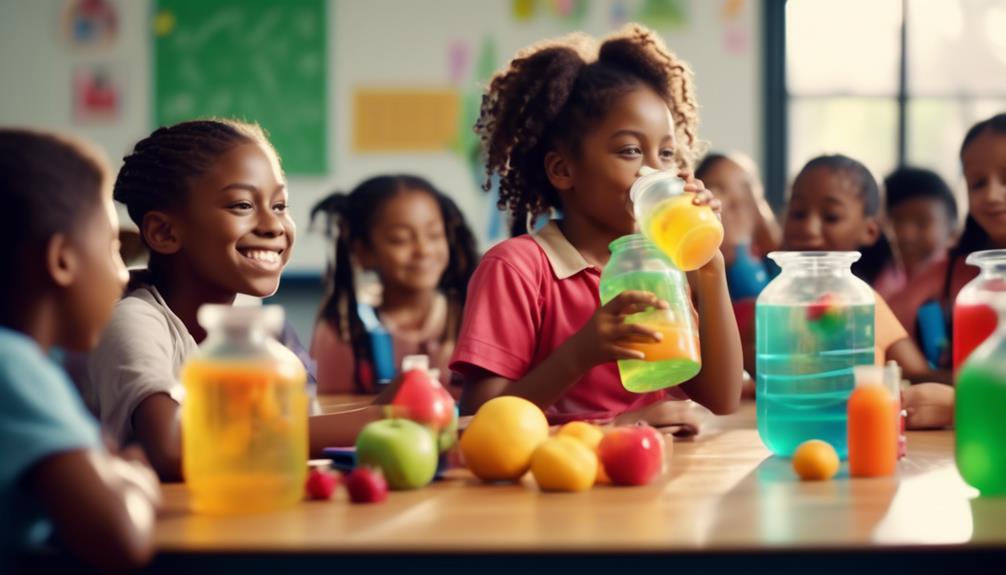What to Do to Encourage Hydration During School Hours

Strategies and initiatives to encourage hydration during school hours include:
- Creating accessible water stations
- Incorporating water-based activities
These efforts aim to ensure that students stay hydrated for optimal cognitive performance and well-being.
Importance of Hydration for Students
Proper hydration is crucial for students as it improves concentration, cognitive function, and overall well-being. Encouraging drinking water among students is essential to ensure that they stay hydrated throughout the day. Access to clean and safe drinking water in schools plays a vital role in promoting the health and well-being of children.
Drinking enough water helps students maintain their focus and attention during class. Research has shown that even mild dehydration can impair cognitive function, affecting memory, attention, and problem-solving skills. By encouraging students to drink water regularly, schools can help improve their academic performance.
In addition to cognitive benefits, proper hydration also has a positive impact on students' physical health. Drinking water reduces the frequency of illness, as it helps flush out toxins and supports the immune system. It also enhances physical performance and activity levels, allowing students to actively participate in sports and other physical activities.
To promote water intake among students, schools can provide easy access to drinking water by installing water fountains or water stations throughout the campus. Encouraging the use of reusable water bottles can also reduce reliance on single-use plastic bottles, contributing to environmental sustainability.
Creating Accessible Water Stations
Creating accessible water stations is essential for ensuring that students have easy and convenient access to hydration throughout the school day. By implementing the following strategies, schools can promote drinking water availability and prioritize the health and nutrition of their students:
- Strategic placement: Ensure that water stations are located in high-traffic areas throughout the school, such as hallways and cafeterias. This will make it easier for students to access drinking water when needed.
- Inclusive design: Install water fountains and hydration stations that are easily usable by students of all ages and abilities. Consider features like adjustable height, easy-to-use buttons, and wheelchair accessibility.
- Bottle-filling options: Provide options for filling reusable water bottles, such as bottle-filling stations or designated areas with jugs of water. Encouraging students to bring their own bottles promotes sustainability and allows them to stay hydrated throughout the day.
- Regular maintenance: Regularly maintain and clean water stations to ensure safe and hygienic water access for students. This includes checking for any leaks or malfunctions and promptly addressing them.
Implementing Water Breaks
To ensure students stay hydrated during the school day, it's important to schedule regular water breaks as reminders for them to drink water. By implementing timed drink reminders, students are more likely to remember to hydrate throughout the day.
Additionally, encouraging students to keep reusable water bottles at their desks makes it easier for them to access water during class, promoting hydration and overall well-being.
Timed Drink Reminders
Are you looking for effective ways to encourage students to take regular water breaks during school hours? Implementing timed drink reminders can help promote drinking water and ensure students stay hydrated throughout the day. Here are four reasons why timed drink reminders are beneficial:
- Increased water intake: Timed drink reminders prompt students to drink more water, helping them meet their daily hydration needs.
- Easy water access: By setting up hydration stations in different areas of the school, students have convenient access to safe drinking water during their breaks.
- Established schedule: Creating a school-wide schedule for water breaks ensures that all students have dedicated time for hydration, making it a routine part of their day.
- Visual cues: Using posters or digital displays as visual reminders can effectively prompt students to drink water at specific intervals.
Implementing timed drink reminders not only helps students develop healthy habits but also supports the goals of the National School Lunch Program in promoting overall student well-being.
Water Bottle Accessibility
Ensure that water bottles are readily accessible to students throughout the school premises to promote regular water breaks and encourage hydration.
Public schools can implement various strategies to ensure water bottle accessibility. Installing hydration stations or water dispensers in common areas can provide students with easy access to safe water for refilling their bottles. Additionally, encourage students to carry reusable water bottles and allow them to refill during class time.
By making water easily available, schools can help students develop healthy drinking habits and improve their hydration levels.
It's important to educate students about the benefits of regular water consumption and the importance of staying hydrated. Providing convenient and accessible water sources, such as drinking fountains and hydration stations, can contribute to a positive drinking culture and enhance overall water quality in schools.
Encouraging the Use of Reusable Water Bottles
Encourage students to bring their reusable water bottles to school every day, promoting hydration and sustainability.
Here are four reasons why using reusable water bottles is beneficial for both students and the environment:
- Environmental Impact: By using reusable water bottles, students can help reduce the amount of plastic waste generated from single-use plastic bottles. This contributes to a cleaner and healthier environment for future generations.
- Cost Savings: Investing in a reusable water bottle can save students and their families money in the long run. Instead of buying bottled water, students can refill their bottles for free at water fountains or water refill stations in schools.
- Health Benefits: Drinking water throughout the day is essential for children and adolescents to stay hydrated and maintain optimal health. Having their own reusable water bottles readily available encourages students to drink more water, leading to improved concentration and overall well-being.
- Durability and Personalization: Reusable water bottles, especially those made from stainless steel, are long-lasting and can withstand daily use. Students can personalize their bottles with their favorite designs or characters, making hydration a fun and enjoyable experience.
Offering Infused Water Options
To encourage students to stay hydrated, offering infused water options can be an effective strategy.
Infusing water with flavors like lemon, cucumber, berries, or mint can make drinking water more appealing and enjoyable.
Flavorful Hydration Choices
Offering a variety of infused water options can make hydration more appealing to students during school hours. Here are four reasons why incorporating flavorful hydration choices can benefit students:
- Prevent dental health issues: Infused water provides a refreshing alternative to sugary beverages, reducing the risk of tooth decay and cavities.
- Reduce caloric intake: By replacing sugar-sweetened beverages with infused water, students can learn to make healthier choices and decrease their consumption of empty calories.
- Improve cognitive function: Staying hydrated throughout the day helps students maintain optimal brain function, enhancing their ability to focus and retain information.
- Encourage students to drink enough water: Infused water offers a delicious way to make hydration enjoyable, motivating students to drink the recommended amount of water each day.
Infused Water Benefits
By incorporating infused water options, schools can provide students with a flavorful and healthy alternative to plain water, promoting better hydration habits. Infused water offers a fun and creative way to encourage students to drink more water throughout the school day.
Adding fruits like berries, citrus, or cucumbers to water can enhance the flavor and make it more appealing for students. Not only does infused water taste great, but it also provides essential vitamins and minerals from the added fruits, promoting overall health and well-being.
Offering infused water options in schools can help reduce the consumption of sugary beverages, supporting better hydration habits. By providing access to infused water at school breakfast, vending machines, or water coolers, students can enjoy the benefits of hydration while also enjoying the refreshing flavors of infused water.
Incorporating Water-Based Activities
Incorporate water-based activities into your school day to make hydration fun and engaging for students. By offering students opportunities to participate in these activities, you can create a positive environment that's focused on increasing water intake throughout the day. Here are four ways school administrators can incorporate water-based activities:
- Organize water-based extracurricular activities like water balloon fights or water relays. These activities not only promote hydration but also encourage teamwork and physical activity.
- Integrate water-themed educational activities into the curriculum. Experiments on water density, purification, or the water cycle can help students learn about the importance of hydration while engaging their minds.
- Host water-based sports tournaments or competitions. These events provide a fun and competitive way for students to stay hydrated while participating in physical activities.
- Create water-focused art projects. Painting with watercolors or creating water-themed sculptures can ignite students' creativity while reinforcing the importance of drinking water.
Incorporating water-based activities throughout the school day can have a significant impact on students' hydration levels. By making hydration fun and engaging, you can encourage children to choose water instead of sugary drinks and improve their overall well-being.
Educating Students on the Benefits of Hydration
To ensure that students understand the numerous benefits of hydration, it's crucial to educate them about the positive impact it has on their cognitive function and overall well-being. Drinking an adequate amount of water throughout the day can help students perform better in high school by improving their memory and attention. Research conducted by the Public Health Agency of Canada has shown that even mild dehydration can negatively affect cognitive abilities, such as concentration and problem-solving skills.
In addition to cognitive benefits, staying hydrated plays an important role in maintaining a healthy weight and reducing the risk of chronic diseases. Encouraging students to drink water instead of sugary beverages like sports drinks can help prevent excessive calorie intake and promote a balanced diet. Furthermore, if fluoridated water is consumed, hydration can also contribute to preventing dental cavities.
Frequently Asked Questions
What Is an Easy Way to Encourage Students to Stay Hydrated?
You can encourage students to stay hydrated by incorporating water breaks, setting up hydration stations, giving classroom reminders, providing fun water bottles, implementing hydration challenges, using water tracking apps, offering infused water options, providing hydration education, and using a reward system.
How Do You Stay Hydrated at School?
To stay hydrated at school, keep a water bottle with you and set reminders to drink regularly. Take advantage of hydration stations and have classroom water breaks. Try infused water options and educate yourself on the benefits of hydration.
How Can Schools Increase Access to Drinking Water?
Increase access to drinking water by increasing water fountains, installing hydration stations, encouraging the use of reusable water bottles, implementing classroom water breaks, and promoting hydration campaigns. Educate students on the importance of hydration through water challenges and hydration education.
What to Do if Your Teacher Doesn T Let You Get Water?
If your teacher doesn't let you get water, it's important to advocate for your right to stay hydrated. Speak up and discuss the importance of water breaks for your health. Seek support from school administration and explore hydration options outside of school.











